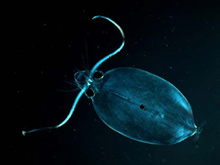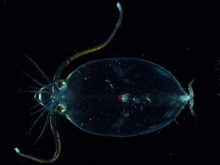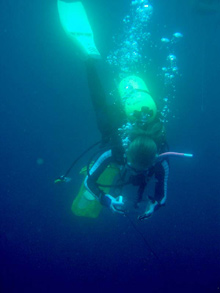

This Caranchid squid, about four inches across, uses transparency to hide from potential predators. Open-water divers can more easily observe these creatures with polarizing filters. Compare the polarized and unpolarized images. Click image for larger view.
Hiding in Plain Sight: Birefringence
August 15, 2004
Sönke JohnsenAssistant Professor
Duke University
Sea animals must solve many problems. How to stay afloat? How to survive crushing pressures? How to keep moving in freezing temperatures? As land dwellers, we can appreciate these problems. But one sea-dweller problem might escape our notice: how to hide? Our terrestrial world is full of objects, large and small, to hide behind. The open ocean, however, is mostly empty and featureless. All it takes is one open-water scuba dive to realize how dreadfully exposed oceanic animals are.
One solution that many animals have found is to be invisible. Using special modifications of their forms and tissues, many oceanic animals are clear as glass. Many are so clear that we cannot see them -- even at two inches away -- which makes them very frustrating to catch. Their muscles and tendons, however, have a special optical quality called "birefringence." This means they alter the light that passes through them.
Normally, we cannot see birefringence; but with a little work we can duplicate the experience on land. The easiest way to is to put on a pair of polaroid sunglasses and hit the highway. The rear windshields of many cars will appear to have fuzzy spots. This is birefringence, caused (in this case) by the process that makes curved glass. The LCD monitors of gas pumps also will be covered with colored fringes, due to the same effect.
Back in the ocean, many animals, especially squid and shrimp, have the living equivalent of polaroid sunglasses over their eyes. This means that they can see the birefringent muscles and tendons in animals that are otherwise invisible. In other words, they can "break the camouflage," and then have their meal.

Blue-water divers use glass jars to capture gelatinous specimens for further study in the ship’s laboratory. Click image for larger view.
We study this by scuba diving in the open ocean (attached to lines so we don't drift away) and filming the animals through cameras fitted with polaroid filters. We catch some of the animals in glass jars (much harder than it looks), and then take close-up shots using the same filters. We were very excited to discover that these animals are much more visible when viewed through these filters. In fact, they are spectacularly beautiful. The whole process is a wonderful mix of adventure, science, art and discovery.
The relationship between birefringence and polarization may explain how animals find their invisible meals. It also enables us to see further into the ocean than we have before. The biggest problem in oceanography is that, even with the brightest light, we can see only about 100 ft (and usually much less). Imagine how your home town would look in a permanent fog. We never get to see the big picture. We are hopeful that by combining these images and polarization measurements with a special algorithm (a calculation process), designed for removing haze in terrestrial pictures, we will get a bigger picture and a better understanding of this marine world.
As often happens, fishermen, underwater archeologists, and others are finding relevance in our basic research. It has also turned out to be very useful to doctors studying cataracts. While I am personally driven by curiosity and the excitement of discovery, I am happy to know that my work may be relevant to all sorts of people -- some who want to see farther underwater, and others who just want to see.























